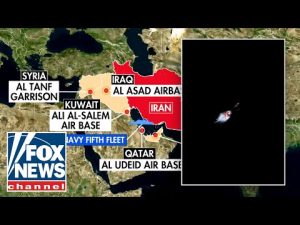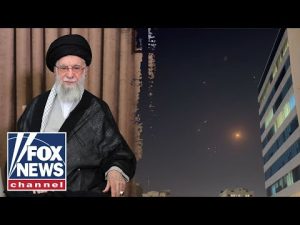**Title: Iran’s Missile Showdown: A Theater of Tension in the Gulf**
In the ongoing saga of international relations involving Iran and its neighbors, the latest developments reveal a complex mix of threats, military posturing, and a hint of theatrics. In recent days, Iran has launched a series of missiles aimed not at inflicting serious damage but rather, it seems, at impressing its domestic audience. With incoming fire directed at locations like Qatar and Bahrain, many are left wondering whether this is truly a show of strength or merely a desperate performance in the stage of geopolitics.
As missiles flew over the Persian Gulf, Iran attempted to display military might, claiming their attacks posed little threat to their “friendly and brotherly neighbors,” like Qatar. Meanwhile, Qatar communicates its reassurance of safety with reports of no casualties or damage incurred during the missile barrage. This has left many scratching their heads when pondering the true intent behind Iran’s launch; it is as if they were sending a message to their citizens while simultaneously walking a tightrope of aggression—trying not to set off alarms with the U.S. military, which remains ever vigilant.
Numerous analysts have pointed out that Iran’s missile capabilities appear to be significantly weakened, potentially due to targeted strikes that have dismantled their ability to launch effective counterattacks. And with the backdrop of a robust defense system in Israel, which intercepted many incoming projectiles, it becomes evident that Iran’s military posturing may resemble more of a bluster than an outright attack. For many, this raises interesting questions about Iran’s endgame: Are they attempting to gather allies, or merely staving off embarrassment after suffering military setbacks?
Indeed, the use of drones and missiles has sparked discussion about the nature of modern warfare. With U.S. military bases in nearby regions maintaining a state of readiness, the technology at their disposal—like advanced missile defense systems—makes it clear that Iran’s missile circus may be more about saving face. These tensions manifest theatrically, allowing Iran to appear defiant while the reality dictates a very different narrative where their military capability is diminished and under scrutiny.
Meanwhile, as sirens blare in Bahrain and other areas, U.S. government branches prepare for all possibilities. Military aircraft respond swiftly, taking to the skies at incredible speeds, ready to react if necessary. The near instantaneous nature of this readiness showcases the state of alertness and capability that U.S. forces maintain in light of these provocations. And amid it all, there’s an underlying current of faith and hope for peace—even in a landscape fraught with uncertainty.
As the global community anxiously watches, the tone of this conflict oscillates between real danger and political theater. With President Trump’s administration navigating such turbulent waters, many believe the potential for avoiding boots on the ground and maintaining peace in the region could represent a monumental achievement. After all, with no U.S. casualties reported and a strong military response always at the ready, it seems, for now, the odds of a major escalation may have shifted. As this conflict unfolds, all eyes remain glued to the Gulf, waiting to see what the next act in this complex drama will bring.







